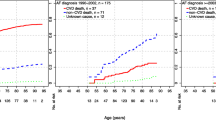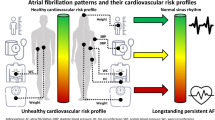Abstract
Background
Risk factor management is crucial in the management of atrial fibrillation (AF). We investigated the association of changes in cardiovascular health (CVH) levels after AF diagnosis with incident cardiovascular events and mortality.
Methods
From the Korea National Health Insurance Service database, 76,628 patients newly diagnosed with AF (2005–2015) with information on health examinations before and after AF diagnosis were assessed. According to the change in the 12-point CVH score before and after AF diagnosis, patients were stratified into four groups: consistently low (score 0–7 to 0–7), high-to-low (8–12 to 0–7), low-to-high (0–7 to 8–12), and consistently high (8–12 to 8–12) CVH levels. Risks of cardiovascular events and death were analyzed using weighted Cox regression models with inverse probability of treatment weighting (IPTW) for balance across study groups.
Results
The mean age of study participants was 58.3 years, 50,285 were men (63.1%), and the mean follow-up was 5.5 years. After IPTW, low-to-high (hazard ratio [95% confidence interval], 0.83 [0.76–0.92]) and consistently high (0.80 [0.74–0.87]) CVH levels were associated with a lower risk of ischemic stroke than consistently low CVH. Low-to-high (0.66 [0.52–0.84]) and consistently high (0.52 [0.42–0.64]) CVH levels were associated with a lower risk of acute myocardial infarction. Maintaining high CVH was associated with reduced risks of heart failure hospitalization (0.85 [0.75–0.95]) and all-cause death (0.82 [0.77–0.88]), respectively, compared with consistently low CVH.
Conclusions
Improving CVH levels and maintaining high CVH levels after AF diagnosis is associated with lower risks of subsequent cardiovascular events and mortality.
Graphical abstract





Similar content being viewed by others
Data and materials availability
All raw data are accessible from the designated terminals approved by the National Health Insurance Sharing Service (https://nhiss.nhis.or.kr/).
Abbreviations
- AF:
-
Atrial fibrillation
- AHA:
-
The American Heart Association
- ASD:
-
Absolute standardized difference
- BP:
-
Blood pressure
- CCI:
-
Charlson comorbidity index
- CI:
-
Confidence interval
- CKD:
-
Chronic kidney disease
- COPD:
-
Chronic obstructive pulmonary disease
- CVD:
-
Cardiovascular disease
- CVH:
-
Cardiovascular health
- HF:
-
Heart failure
- HR:
-
Hazard ratio
- ICD-10:
-
The International Classification of Diseases-10th revision
- IPTW:
-
Inverse probability of treatment weighting
- MI:
-
Myocardial infarction
- NHID:
-
The National Health Information Database
- NHIS:
-
The National Health Insurance Service of Korea
- PAD:
-
Peripheral artery disease
- PY:
-
Person-years
References
Chugh SS, Havmoeller R, Narayanan K, Singh D, Rienstra M, Benjamin EJ et al (2014) Worldwide epidemiology of atrial fibrillation: a Global Burden of Disease 2010 Study. Circulation 129:837–847. https://doi.org/10.1161/circulationaha.113.005119
Ruddox V, Sandven I, Munkhaugen J, Skattebu J, Edvardsen T, Otterstad JE (2017) Atrial fibrillation and the risk for myocardial infarction, all-cause mortality and heart failure: a systematic review and meta-analysis. Eur J Prev Cardiol 24:1555–1566. https://doi.org/10.1177/2047487317715769
January CT, Wann LS, Calkins H, Chen LY, Cigarroa JE, Cleveland JC Jr et al (2019) 2019 AHA/ACC/HRS Focused Update of the 2014 AHA/ACC/HRS Guideline for the Management of Patients With Atrial Fibrillation: A Report of the American College of Cardiology/American Heart Association Task Force on Clinical Practice Guidelines and the Heart Rhythm Society. J Am Coll Cardiol 74:104–132. https://doi.org/10.1016/j.jacc.2019.01.011
Andrade JG, Aguilar M, Atzema C, Bell A, Cairns JA, Cheung CC et al (2020) The 2020 Canadian Cardiovascular Society/Canadian Heart Rhythm Society Comprehensive Guidelines for the Management of Atrial Fibrillation. Can J Cardiol 36:1847–1948. https://doi.org/10.1016/j.cjca.2020.09.001
Lloyd-Jones DM, Hong Y, Labarthe D, Mozaffarian D, Appel LJ, Van Horn L et al (2010) Defining and setting national goals for cardiovascular health promotion and disease reduction: the American Heart Association’s strategic Impact Goal through 2020 and beyond. Circulation 121:586–613. https://doi.org/10.1161/circulationaha.109.192703
Fang N, Jiang M, Fan Y (2016) Ideal cardiovascular health metrics and risk of cardiovascular disease or mortality: a meta-analysis. Int J Cardiol 214:279–283. https://doi.org/10.1016/j.ijcard.2016.03.210
Dong C, Rundek T, Wright CB, Anwar Z, Elkind MS, Sacco RL (2012) Ideal cardiovascular health predicts lower risks of myocardial infarction, stroke, and vascular death across whites, blacks, and hispanics: the northern Manhattan study. Circulation 125:2975–2984. https://doi.org/10.1161/circulationaha.111.081083
van Sloten TT, Tafflet M, Périer MC, Dugravot A, Climie RED, Singh-Manoux A et al (2018) Association of change in cardiovascular risk factors with incident cardiovascular events. JAMA 320:1793–1804. https://doi.org/10.1001/jama.2018.16975
Yang PS, Jang E, Yu HT, Kim TH, Pak HN, Lee MH et al (2021) Changes in cardiovascular risk factors and cardiovascular events in the elderly population. J Am Heart Assoc 10:e019482. https://doi.org/10.1161/jaha.120.019482
Gómez-Outes A, Lagunar-Ruíz J, Terleira-Fernández AI, Calvo-Rojas G, Suárez-Gea ML, Vargas-Castrillón E (2016) Causes of death in anticoagulated patients with atrial fibrillation. J Am Coll Cardiol 68:2508–2521. https://doi.org/10.1016/j.jacc.2016.09.944
Cheol Seong S, Kim YY, Khang YH, Heon Park J, Kang HJ, Lee H et al (2017) Data resource profile: the national health information Database of the National Health Insurance Service in South Korea. Int J Epidemiol 46:799–800. https://doi.org/10.1093/ije/dyw253
Seong SC, Kim YY, Park SK, Khang YH, Kim HC, Park JH et al (2017) Cohort profile: the National Health Insurance Service-National Health Screening Cohort (NHIS-HEALS) in Korea. BMJ Open 7:e016640. https://doi.org/10.1136/bmjopen-2017-016640
Austin PC, Stuart EA (2015) Moving towards best practice when using inverse probability of treatment weighting (IPTW) using the propensity score to estimate causal treatment effects in observational studies. Stat Med 34:3661–3679. https://doi.org/10.1002/sim.6607
McCaffrey DF, Griffin BA, Almirall D, Slaughter ME, Ramchand R, Burgette LF (2013) A tutorial on propensity score estimation for multiple treatments using generalized boosted models. Stat Med 32:3388–3414. https://doi.org/10.1002/sim.5753
Austin PC (2009) Balance diagnostics for comparing the distribution of baseline covariates between treatment groups in propensity-score matched samples. Stat Med 28:3083–3107. https://doi.org/10.1002/sim.3697
Austin PC, Lee DS, Fine JP (2016) Introduction to the analysis of survival data in the presence of competing risks. Circulation 133:601–609. https://doi.org/10.1161/circulationaha.115.017719
Fine JP, Gray RJ (1999) A proportional hazards model for the subdistribution of a competing risk. J Am Stat Assoc 94:496–509. https://doi.org/10.1080/01621459.1999.10474144
Huffman MD, Capewell S, Ning H, Shay CM, Ford ES, Lloyd-Jones DM (2012) Cardiovascular health behavior and health factor changes (1988–2008) and projections to 2020: results from the National Health and Nutrition Examination Surveys. Circulation 125:2595–2602. https://doi.org/10.1161/circulationaha.111.070722
Shah AM, Claggett B, Folsom AR, Lutsey PL, Ballantyne CM, Heiss G et al (2015) Ideal cardiovascular health during adult life and cardiovascular structure and function among the elderly. Circulation 132:1979–1989. https://doi.org/10.1161/circulationaha.115.017882
Joung B (2019) Risk factor management for atrial fibrillation. Korean Circ J 49:794–807. https://doi.org/10.4070/kcj.2019.0212
Wang TJ, Parise H, Levy D, D’Agostino RB Sr, Wolf PA, Vasan RS et al (2004) Obesity and the risk of new-onset atrial fibrillation. JAMA 292:2471–2477. https://doi.org/10.1001/jama.292.20.2471
Tedrow UB, Conen D, Ridker PM, Cook NR, Koplan BA, Manson JE et al (2010) The long- and short-term impact of elevated body mass index on the risk of new atrial fibrillation the WHS (women’s health study). J Am Coll Cardiol 55:2319–2327. https://doi.org/10.1016/j.jacc.2010.02.029
Kim D, Yang PS, Kim TH, Jang E, Shin H, Kim HY et al (2018) Ideal Blood Pressure in Patients With Atrial Fibrillation. J Am Coll Cardiol 72:1233–1245. https://doi.org/10.1016/j.jacc.2018.05.076
Kim TH, Yang PS, Yu HT, Jang E, Shin H, Kim HY et al (2019) Effect of hypertension duration and blood pressure level on ischaemic stroke risk in atrial fibrillation: nationwide data covering the entire Korean population. Eur Heart J 40:809–819. https://doi.org/10.1093/eurheartj/ehy877
Lee SS, Ae Kong K, Kim D, Lim YM, Yang PS, Yi JE et al (2017) Clinical implication of an impaired fasting glucose and prehypertension related to new onset atrial fibrillation in a healthy Asian population without underlying disease: a nationwide cohort study in Korea. Eur Heart J 38:2599–2607. https://doi.org/10.1093/eurheartj/ehx316
Jin MN, Yang PS, Song C, Yu HT, Kim TH, Uhm JS et al (2019) Physical activity and risk of atrial fibrillation: a nationwide cohort study in general population. Sci Rep 9:13270. https://doi.org/10.1038/s41598-019-49686-w
Guo L, Zhang S (2017) Association between ideal cardiovascular health metrics and risk of cardiovascular events or mortality: a meta-analysis of prospective studies. Clin Cardiol 40:1339–1346. https://doi.org/10.1002/clc.22836
Hindricks G, Potpara T, Dagres N, Arbelo E, Bax JJ, Blomström-Lundqvist C et al (2021) 2020 ESC Guidelines for the diagnosis and management of atrial fibrillation developed in collaboration with the European Association for Cardio-Thoracic Surgery (EACTS): The Task Force for the diagnosis and management of atrial fibrillation of the European Society of Cardiology (ESC) Developed with the special contribution of the European Heart Rhythm Association (EHRA) of the ESC. Eur Heart J 42:373–498. https://doi.org/10.1093/eurheartj/ehaa612
Lip GYH (2017) The ABC pathway: an integrated approach to improve AF management. Nat Rev Cardiol 14:627–628. https://doi.org/10.1038/nrcardio.2017.153
Kim D, Yang PS, Yu HT, Kim TH, Jang E, Sung JH et al (2019) Risk of dementia in stroke-free patients diagnosed with atrial fibrillation: data from a population-based cohort. Eur Heart J 40:2313–2323. https://doi.org/10.1093/eurheartj/ehz386
Acknowledgements
Access to the NHID was provided by the NHIS of Korea. The authors would like to thank the NHIS for their cooperation.
Funding
This research was supported by a grant of Patient-Centered Clinical Research Coordinating Center (PACEN) funded by the Ministry of Health & Welfare, Republic of Korea (grant number: HC19C0130). The funders had no role in the design and conduct of the study; collection, management, analysis, and interpretation of the data; preparation, review, or approval of the manuscript; and decision to submit the manuscript for publication.
Author information
Authors and Affiliations
Contributions
BJ and P-SY contributed to the conceptualization and design of the work, project administration, and critical revision of the manuscript. SC contributed to the conception and design of the work, and analysis, interpretation, and visualization of data for the work, and original drafting of the manuscript. P-SY and EJ contributed to the acquisition and analysis of data for the work. P-SY, DK, SCY, and BJ contributed to the supervision and validation of the work. DK, SCY, J-HS, HTY, T-HK, H-NP, and M-HL contributed to reviewing and revising the manuscript. All the authors approved the final version of the manuscript.
Corresponding author
Ethics declarations
Conflict of interest
Dr. Boyoung Joung has served as a speaker for Bayer, BMS/Pfizer, Medtronic, and Daiichi-Sankyo and received research funds from Medtronic and Abbott. None of the other authors have any disclosures to declare. No fees were directly or personally received. The other authors have nothing to declare.
Ethics approval
This study was approved by the Institutional Review Board of the Yonsei University Health System (4-2021-1357). This study was conducted in compliance with the ethical guidelines of the Declaration of Helsinki.
Consent to participate and publish
The requirement for informed consent was waived because this study used anonymous data.
Supplementary Information
Below is the link to the electronic supplementary material.
Rights and permissions
About this article
Cite this article
Cho, S., Yang, PS., Kim, D. et al. Association of changes in cardiovascular health levels with incident cardiovascular events and mortality in patients with atrial fibrillation. Clin Res Cardiol 112, 724–735 (2023). https://doi.org/10.1007/s00392-022-02058-3
Received:
Accepted:
Published:
Issue Date:
DOI: https://doi.org/10.1007/s00392-022-02058-3




